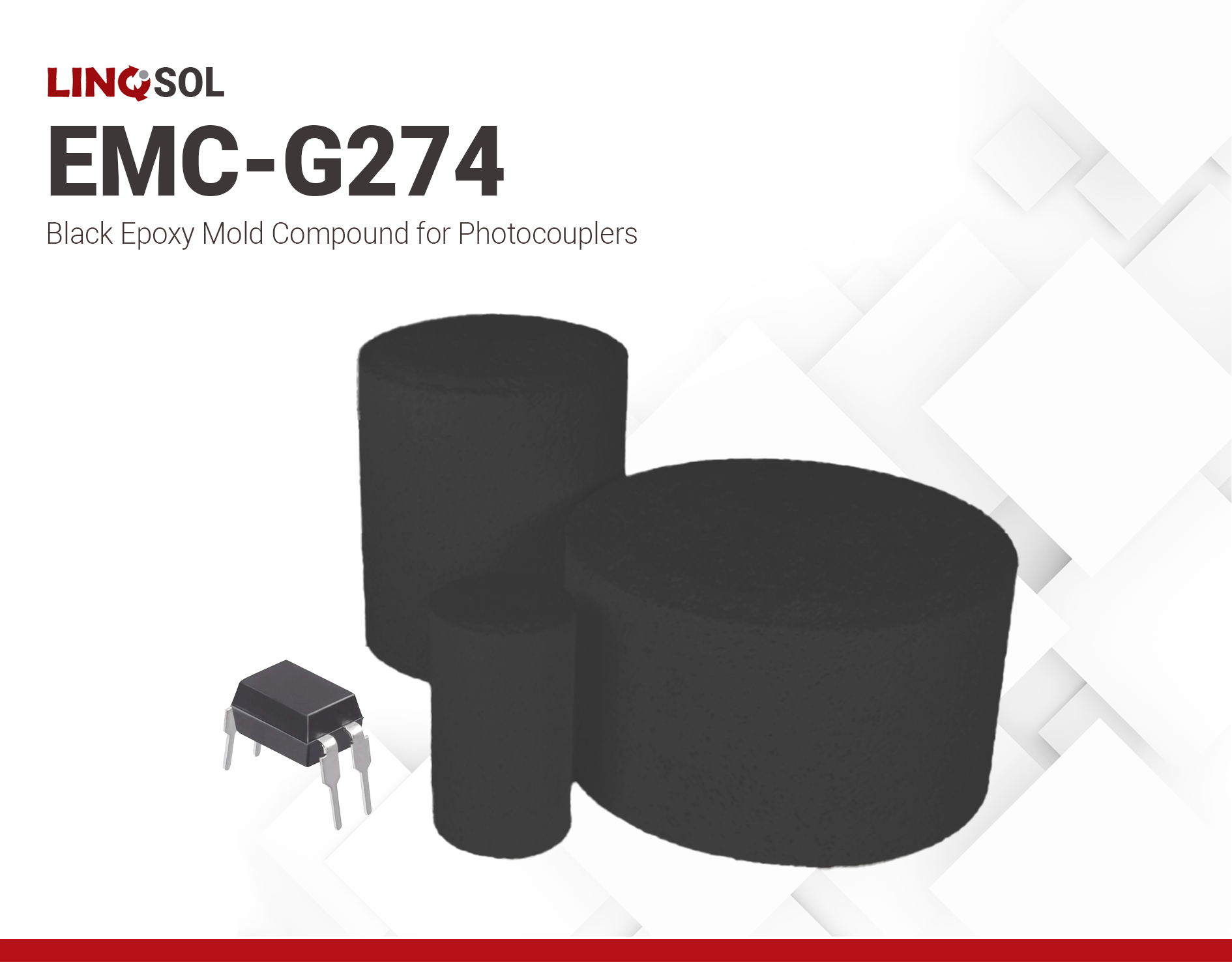EMC-G274 | Epoxy Molding Compound for Photocouplers
- Good moldability
- Designed for photocoupler / optocoupler devices
- Excellent mechanical integrity
Product Description
LINQSOL™ EMC-G274 is a halogen-free epoxy molding compound engineered for photocoupler/optocoupler devices. It offers excellent moldability (spiral flow of 105 cm at 175 °C), low moisture absorption ( 0.5% PCT 24 h), and superior mechanical strength (flexural strength = 160 MPa). With a glass transition of 147 °C ensures reliability in high-stress, high-temperature environments. Its factor in low ion content and high volume resistivity makes it ideal for sensitive optoelectronic applications.
LINQSOL EMC-G274 guarantees strong performance and outstanding long-term reliability in demanding environments. This product is deliberately formulated without the inclusion of substances prohibited by the European Union RoHS and REACH. Overall, EMC-G274 seamlessly integrates advanced material properties, safety compliance, and superior performance to deliver a reliable solution for semiconductor device encapsulation.
LINQSOL EMC-G274 is available in custom pellet dimensions. Contact us for specifications.
Key Features
- Fast Gel & High Flowability – 27 s gel time, 105 cm spiral flow at 175 °C: enables efficient molding cycles.
- High Tg (147 °C) – Maintains dimensional and thermal stability under elevated temperature.
- Low Moisture Absorption (0.5%) – Enhances reliability by mitigating “popcorn” cracking in moisture-sensitive devices.
- Strong Mechanical Integrity (160 MPa) – Delivers robust package strength and resistance to mechanical stress.
- High Electrical Insulation – Volume resistivity 8 × 10¹⁵ Ω·cm ensures excellent dielectric performance.
- UL‑94 V‑0 Flame Resistance – Complies with stringent flammability standards for electronic components.
Ideal for photocoupler/optocoupler devices requiring:
- Reliable encapsulation in transfer molding applications
- Low-stress dielectric protection in optical signal pathways
- High-voltage isolation in light-transmitting packages
- Thermal cycling stability and moisture-resistant packaging
Technical Specifications
| General Properties | |||||||
| Specific Gravity Specific Gravity Specific gravity (SG) is the ratio of the density of a substance to the density of a reference substance; equivalently, it is the ratio of the mass of a substance to the mass of a reference substance for the same given volume. For liquids, the reference substance is almost always water (1), while for gases, it is air (1.18) at room temperature. Specific gravity is unitless. | 1.89 | ||||||
| Physical Properties | |||||||
| Spiral Flow @ 175°C | 105 cm | ||||||
| Chemical Properties | |||||||
| |||||||
| Water Absorption | 0.5 % | ||||||
| Electrical Properties | |||||||
| |||||||
| Volume Resistivity Volume Resistivity Volume resistivity, also called volume resistance, bulk resistance or bulk resistivity is a thickness dependent measurement of the resistivity of a material perpendicular to the plane of the surface. | 8.0x1015 Ohms⋅cm | ||||||
| Mechanical Properties | |||||||
| |||||||
| |||||||
| Thermal Properties | |||||||
| |||||||
| |||||||
| Glass Transition Temperature (Tg) Glass Transition Temperature (Tg) The glass transition temperature for organic adhesives is a temperature region where the polymers change from glassy and brittle to soft and rubbery. Increasing the temperature further continues the softening process as the viscosity drops too. Temperatures between the glass transition temperature and below the decomposition point of the adhesive are the best region for bonding. The glass-transition temperature Tg of a material characterizes the range of temperatures over which this glass transition occurs. | 147 °C | ||||||
| UL 94 Rating UL 94 Rating Flammability rating classification. It determines how fast a material burns or extinguishes once it is ignited. HB: slow burning on a horizontal specimen; burning rate less than 76 mm/min for thickness less than 3 mm or burning stops before 100 mm V-2: burning stops within 30 seconds on a vertical specimen; drips of flaming particles are allowed. V-1: burning stops within 30 seconds on a vertical specimen; drips of particles allowed as long as they are not inflamed. V-0: burning stops within 10 seconds on a vertical specimen; drips of particles allowed as long as they are not inflamed. 5VB: burning stops within 60 seconds on a vertical specimen; no drips allowed; plaque specimens may develop a hole. 5VA: burning stops within 60 seconds on a vertical specimen; no drips allowed; plaque specimens may not develop a hole | V-0 | ||||||
Additional Information
EMC-G274 Recommended Mold Parameters
| Parameter | Value | Unit |
|---|---|---|
| Molding temperature | 170–180 | °C |
| Transfer pressure | 40–70 | kgf/cm2 |
| Transfer time | 10–20 | s |
| Cure time at 175 °C | 120–150 | s |
| Post-mold cure time at 175 °C | 6–8 | h |
The curing conditions provided are recommended guidelines based on typical laboratory results. Actual curing parameters should be defined and validated by the user to ensure compatibility with specific materials, part geometries, and end-use requirements. It is the user’s responsibility to optimize and confirm curing conditions that meet their performance and quality standards.
Processing Instructions
Before use, let LINQSOL™ EMC-G274 reach room temperature (23 ±5 °C) for 24 hours. Keep the bag unopened and stored in a dry location with a relative humidity of ≤50% during thawing to prevent moisture contamination.
- Use the materials within 72 hours after removing the container from cold storage.
Storage and Handling
LINQSOL™ EMC-G274 is available in pressed pellets in a wide range of sizes to meet specific customer needs. To ensure product integrity, keep it away from oxidizing materials. For long-term storage, maintain a cold environment. The shelf life when stored below 5 °C is 183 days.
The technical information presented in this document is provided for reference only and does not constitute a guarantee of specific properties or performance. Actual results may vary depending on individual conditions and application methods. Users are strongly advised to perform their own testing and validation to determine suitability for their intended use and compliance with relevant regulations.





